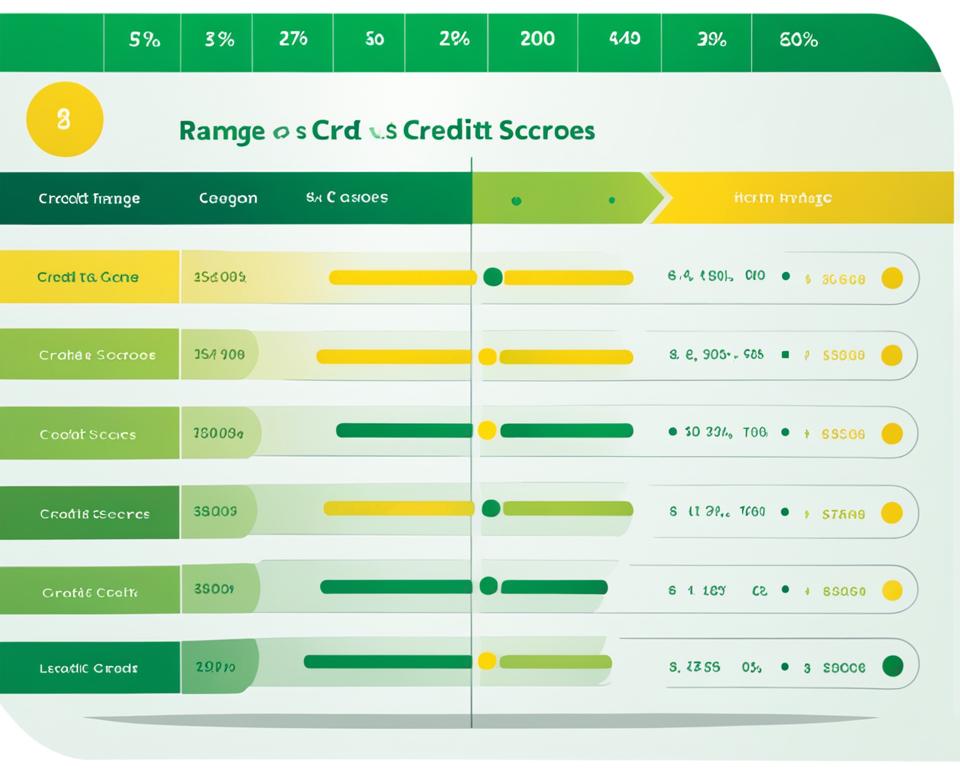When it comes to credit scores, it can sometimes feel like there are countless numbers to keep track of. But just how many credit scores are there, and what are the different types and scoring models? Understanding this information is crucial for managing your credit health effectively.
The most recognized credit scoring model is the FICO score, developed by the Fair Isaac Company. However, it’s important to note that FICO has more than 50 different versions of the score, each tailored to specific lending purposes. This means that your FICO score for an auto loan could be different from your score for mortgages or credit cards.
In addition to the FICO score, other credit scoring models are also used by lenders and institutions. For example, the VantageScore model, created by the three major credit reporting bureaus, is an alternative to the FICO score and takes into account factors such as payment history, credit utilization, and balances.
It’s also worth noting that there are custom scoring models used by some lenders, which are specifically created to meet their lending criteria. These custom models may differ from the widely recognized scoring models like FICO and VantageScore.
Understanding the different credit scoring models and how they work can help you navigate the world of credit scores more effectively. It’s essential to monitor your credit reports regularly and maintain good credit habits to ensure a favorable credit score across various scoring models.
Key Takeaways:
- There are multiple credit scoring models used by lenders, including the widely recognized FICO score and the VantageScore.
- FICO has more than 50 different versions of the score, each tailored to specific lending purposes.
- Other credit scoring models, such as the VantageScore, take into account factors like payment history and credit utilization.
- Some lenders use custom scoring models that differ from the widely recognized models.
- Monitoring credit reports and maintaining good credit habits are essential for a favorable credit score across various scoring models.
What Is a Credit Score?
A credit score is a 3-digit number that reflects the likelihood that a consumer will repay their debts. It is a key factor used by lenders to assess creditworthiness and determine the terms of credit agreements. Credit scores are calculated using various credit score models, which evaluate different factors to determine an individual’s creditworthiness.
The most widely recognized credit score models are the FICO score and the VantageScore. These models analyze factors such as payment history, amounts owed, length of credit history, new credit, and credit mix, among others. By assessing these factors, credit score models aim to predict the likelihood of repayment and provide lenders with an indication of the borrower’s credit risk.
“Your credit score is the most significant diagnostic tool in a lender’s toolbox that helps them decide whether to grant you credit or not.”
When you apply for a loan or credit card, lenders typically request your credit score to evaluate the likelihood of repayment. A higher credit score indicates a lower credit risk, making it more likely for the lender to approve your application and offer favorable terms, such as lower interest rates and higher credit limits.
“It’s important to understand that different credit score models may produce slightly different scores, as they weigh factors differently and assess creditworthiness from varying perspectives.”
| Credit Score Model | Key Factors Considered |
|---|---|
| FICO Score | Payment history, amounts owed, length of credit history, new credit, credit mix |
| VantageScore | Payment history, credit utilization, credit age and mix, recent credit behavior, available credit |
While the FICO score and VantageScore are the most widely used credit score models, other models exist as well. These models may have their unique methodologies and weigh factors differently, resulting in variations in credit scores.
Understanding your credit score and how it is calculated is crucial for managing your credit health and making informed financial decisions. By monitoring your credit score and taking steps to improve it, you can increase your likelihood of obtaining credit and accessing better loan terms in the future.
Credit Scoring Models
Credit scoring models play a crucial role in assessing an individual’s creditworthiness. These models employ statistical analysis to evaluate various factors that determine credit scores. By incorporating payment history, frequency of payments, debt levels, credit charge-offs, and the number of credit cards held, these models produce a comprehensive evaluation of a person’s creditworthiness.
The model uses a credit score formula that assigns different weights to each factor. This formula calculates the overall credit score based on the collective evaluation of these factors. The credit score serves as an indicator of an individual’s creditworthiness and helps lenders make informed decisions when approving credit applications.
“Credit scoring models enable credit bureaus to assess the financial health and creditworthiness of individuals. By analyzing various factors, these models provide lenders with valuable information to mitigate risk and make sound lending decisions.”
The use of credit scoring models has revolutionized the lending industry by providing a consistent and objective methodology for evaluating borrowers. These models remove subjective biases and human errors from the credit evaluation process, allowing lenders to make accurate and reliable credit decisions.
To better understand credit scoring models, it is essential to recognize their statistical foundation. Statistical analysis aids in identifying patterns, trends, and relationships within credit data. This analysis forms the basis for the credit score formula, ensuring a reliable and robust evaluation of creditworthiness.
In summary, credit scoring models utilize statistical analysis and a credit score formula to assess creditworthiness. By considering various factors, these models provide lenders with essential information to make informed lending decisions.
| Factors Considered in Credit Scoring Models | Weight in Credit Score Formula |
|---|---|
| Payment history | 30% |
| Frequency of payments | 20% |
| Debt levels | 25% |
| Credit charge-offs | 15% |
| Number of credit cards held | 10% |
Note: The weights assigned to each factor may vary depending on the specific credit scoring model.

FICO Scoring Model
The FICO scoring model, developed by the Fair Isaac Company, is widely used by lenders to evaluate creditworthiness. FICO has more than 50 different versions of the FICO score, each tailored to specific lending purposes. The most recent versions include FICO 9 and FICO 10, which introduced changes such as less weight on unpaid medical bills and the inclusion of rental history in credit history.
| FICO Scoring Model Versions | Key Features |
|---|---|
| FICO 9 | – Less weight on unpaid medical bills – Inclusion of rental history in credit history – Reduced impact of certain collection accounts |
| FICO 10 | – Enhancements in assessing credit risk – Incorporation of trended data for a more comprehensive credit assessment – Improved treatment of personal loans and credit cards |
Each version of the FICO scoring model is designed to provide lenders with a more accurate assessment of an individual’s creditworthiness, taking into account specific factors that are relevant to different lending purposes. By using these different versions, lenders can make more informed decisions when evaluating loan applications and determining interest rates.
“The FICO scoring model is constantly evolving to reflect changes in lending practices and consumer credit behavior. The introduction of FICO 9 and FICO 10 showcases the company’s commitment to providing lenders with the most accurate and predictive credit scoring tools.”
FICO Score Variations
It’s important to note that FICO scores can vary depending on the specific version of the scoring model used by a lender. The FICO score variations are designed to cater to the unique requirements of different industries and lending purposes. For example, the FICO Auto Score may place more emphasis on factors that are relevant to auto loans, such as previous auto payment history and outstanding auto loan balances.
It’s also worth mentioning that while lenders predominantly use FICO scores, other credit scoring models like VantageScore may also be used in certain situations, leading to further variations in credit scores.
How Are FICO Scores Calculated?
FICO scores, one of the most recognized credit scoring models, are calculated using five main factors: payment history, credit utilization, credit history, credit mix, and new credit. These factors play a crucial role in determining an individual’s creditworthiness and financial responsibility.
1. Payment History (35%): The payment history reflects a borrower’s ability to make timely payments on their debts. Lenders consider factors such as late payments, delinquencies, and public records when evaluating this aspect of creditworthiness.
2. Credit Utilization (30%): Credit utilization is the percentage of available credit that a borrower is currently using. It measures how much of their available credit they have utilized and can impact their FICO score. Keeping credit card balances low and manageable is key to maintaining a healthy credit utilization ratio.
3. Credit History (15%): The length of a borrower’s credit history is also taken into account when calculating their FICO score. A longer credit history can demonstrate a borrower’s ability to handle credit responsibly over time.
4. Credit Mix (10%): The types of credit accounts a borrower has can influence their FICO score. A healthy credit mix might include a combination of credit cards, installment loans, and mortgages, indicating a borrower’s ability to manage different types of credit responsibly.
5. New Credit (10%): Opening new credit accounts can impact a borrower’s FICO score. Lenders consider the number of new credit inquiries and recently opened accounts when assessing creditworthiness. It’s important to be mindful of multiple credit applications within a short period as it may raise concerns for lenders.
Remember, the FICO score calculation is specific to each individual and takes into account their unique credit history and financial behavior. Paying bills on time, keeping credit card balances low, and maintaining a diverse credit mix can contribute to a higher FICO score and improve overall creditworthiness.

| FICO Score Factors | Weight in FICO Score Calculation |
|---|---|
| Payment History | 35% |
| Credit Utilization | 30% |
| Credit History | 15% |
| Credit Mix | 10% |
| New Credit | 10% |
VantageScore Model
The VantageScore model is an alternative credit scoring model developed by the three major credit reporting bureaus: Experian, Equifax, and TransUnion. It was created to provide a different perspective on creditworthiness compared to the widely used FICO score. The VantageScore model takes into account various factors to calculate an individual’s credit score, including:
- Payment History
- Credit Utilization
- Credit Balances
- Depth of Credit
- Recent Credit
- Available Credit
Of these factors, payment history and credit utilization have the most significant impact on the VantageScore calculation, accounting for 40% and 20% respectively. This highlights the importance of making timely payments and maintaining a low credit utilization ratio to achieve a favorable VantageScore.
Unlike FICO scores, which have many different versions tailored to specific lending purposes, the VantageScore model has fewer variations. This simplifies the credit scoring process and makes it easier for lenders and consumers to understand.
“The VantageScore model provides a fresh approach to credit scoring, offering consumers and lenders a transparent and consistent credit evaluation method.”
Comparing FICO and VantageScore
| FICO Score | VantageScore |
|---|---|
| Developed by the Fair Isaac Company | Developed by the three major credit reporting bureaus |
| More than 50 versions tailored to specific lending purposes | Fewer variations for a simpler credit scoring process |
| Payment history and credit utilization heavily weighted | Payment history and credit utilization heavily weighted |
| Used by a wide range of lenders | Increasingly adopted by lenders |
The VantageScore model offers consumers an additional perspective on their creditworthiness and provides lenders with an alternative credit evaluation method. It is important for individuals to be aware of their VantageScore and understand how it is calculated, as it can impact loan eligibility and interest rates.
Other Credit Scoring Models
In addition to FICO and VantageScore, there are other credit scoring models that lenders and credit bureaus use to assess creditworthiness. These alternative models provide additional insights into a person’s credit history and financial stability.
One such model is TransRisk, which focuses on evaluating the risk associated with new accounts. It considers factors such as the individual’s credit utilization, payment history, and the length of their credit history. TransRisk provides lenders with an assessment of the individual’s creditworthiness specifically related to new credit obligations.
Experian’s National Equivalency Score is another proprietary scoring model used by Experian. This score takes into account various credit factors to determine a person’s creditworthiness. It provides a comprehensive assessment of an individual’s credit history, including factors such as payment history, credit utilization, and the variety of credit accounts they hold.
“Other credit scoring models like TransRisk and Experian’s National Equivalency Score complement the widely known FICO and VantageScore models by providing lenders with a more holistic view of a person’s creditworthiness. These alternative scores offer additional perspectives and can help lenders make more informed decisions when assessing credit applications.”
Why Do I Have So Many Credit Scores?
When it comes to credit scores, it’s not uncommon to have multiple scores. This can be attributed to various factors, including the different credit bureaus, credit reporting variations, and the use of different scoring models and versions.
Each of the three major credit bureaus – Experian, Equifax, and TransUnion – generates its own credit report based on the information reported by lenders. These reports may contain slight differences in data, which can lead to variations in credit scores. For example, if one lender reports your payment history to Equifax but not to Experian, your credit scores from these two bureaus may differ.
Furthermore, credit scores can also vary depending on the scoring model and version used. The most widely recognized scoring model is the FICO score, developed by the Fair Isaac Company. However, FICO has more than 50 different versions of the score, each tailored to specific lending purposes. This means that a lender may be using an older version of the FICO score, while another lender may be using the latest version.
Additionally, there are alternative scoring models like the VantageScore, which was created by the three major credit reporting bureaus as a competitor to the FICO score. The VantageScore also has its own variations and can produce different credit scores compared to the FICO score.
It’s important to understand that these variations in credit scores are not necessarily a cause for concern. Different lenders and financial institutions may prioritize different aspects of creditworthiness and use different scoring models to assess credit risk. However, it’s always a good idea to regularly monitor your credit reports and address any discrepancies or errors that may arise.
Overall, the existence of multiple credit scores is a result of the different credit bureaus, credit reporting variations, and the use of various scoring models and versions. By staying informed and maintaining good credit habits, you can navigate the credit scoring landscape with confidence.
What Is a Good Credit Score?
A good credit score is essential for qualifying for credit and securing lower interest rates on loans and credit cards. Understanding the range of a good credit score can help individuals gauge their creditworthiness and make informed financial decisions.
For FICO scores, a good credit score typically falls within the range of 670 to 739. On the other hand, VantageScores consider a range of 661 to 780 as good credit. These ranges may slightly vary depending on the specific credit scoring model used by lenders.
Having a good credit score increases the likelihood of qualifying for credit, such as loans and credit cards. Lenders view individuals with good credit scores as less risky and more likely to repay their debts responsibly. This opens up opportunities for individuals to access financing options with better terms and lower interest rates.
Lenders often use credit scores as a key determinant in approving credit applications and assessing the risk involved in lending money. A good credit score gives individuals more bargaining power to negotiate favorable interest rates on loans and credit cards, saving them money in the long run.
It’s important for individuals to regularly monitor their credit scores and take steps to maintain or improve them. This includes paying bills on time, keeping credit card balances low, and managing credit responsibly. By consistently demonstrating good credit habits, individuals can ensure they fall within the good credit score range and enjoy the benefits it brings.
Good Credit Score Range
Here is a breakdown of the good credit score ranges for both FICO scores and VantageScores:
| Credit Score Model | Good Credit Score Range |
|---|---|
| FICO | 670 – 739 |
| VantageScore | 661 – 780 |
It’s important to note that these ranges may vary slightly depending on the specific credit scoring model used by lenders. It’s always a good idea to check with lenders or credit bureaus to understand the score ranges they consider as good credit.

Remember, maintaining a good credit score not only helps individuals qualify for credit but also opens the door to lower interest rates, saving money in the long term.
How Are Credit Scores Calculated?
Credit scores are calculated based on several factors that assess an individual’s creditworthiness. These factors include:
- Payment History: This refers to a person’s track record of making timely payments on their credit obligations, such as loans and credit cards. Payment history is a crucial factor in credit score calculation, as it demonstrates the borrower’s reliability in repaying debts.
- Credit Utilization: Credit utilization measures the amount of credit a person is currently using compared to their total available credit. A lower utilization ratio generally indicates responsible credit management and can positively impact a credit score.
- Credit Mix: Credit mix refers to the different types of credit accounts a person has, such as mortgages, car loans, and credit cards. Having a diverse credit mix can indicate a borrower’s ability to manage various types of credit responsibly, which can influence their credit score.
- New Credit: New credit accounts opened by an individual can affect their credit score. Applying for too much new credit within a short period may raise concerns about the person’s financial stability and can potentially lower their credit score.
The specific weight assigned to each factor varies depending on the scoring model used. For example, some models may give more importance to payment history, while others may focus more on credit utilization or credit mix.
Having a clear understanding of how credit scores are calculated can help individuals make informed decisions to improve their credit health.
How to Check Your Credit Scores and Reports
Checking your credit scores and accessing your credit reports is essential for understanding your credit health and financial standing. Fortunately, there are several methods available for obtaining this information.
Requesting Free Credit Scores
One option is to request a free credit score from each of the three major credit bureaus: Experian, Equifax, and TransUnion. These bureaus provide a free copy of your credit score once every 12 months. You can request your scores online through their websites or by calling their toll-free numbers.
When requesting your free credit scores, it’s important to provide accurate personal information to ensure the bureaus can locate your credit file. You may be required to answer security questions to verify your identity.
Using Credit Monitoring Services
Another convenient method is to use a credit monitoring service. These services often provide access to your credit scores, as well as additional features such as credit alerts and identity theft protection. Many credit monitoring services offer a free trial period, allowing you to test the service before committing to a subscription.
Credit monitoring services typically require you to create an account and provide your personal information. They may also ask for permission to access your credit reports from the credit bureaus.
Checking with Your Bank or Credit Union
If you have a bank account or credit union membership, you can inquire whether they offer access to credit scores. Some financial institutions provide their customers with tools or services that allow them to monitor their credit scores regularly.
Contact your bank or credit union to inquire about any available credit score monitoring options. They can guide you on how to access your scores and provide additional information on credit management.
Regardless of the method you choose, regularly checking your credit scores and reports allows you to stay informed about your credit status and identify any potential errors or discrepancies. This knowledge empowers you to make informed decisions regarding your financial health and take appropriate actions to improve your credit standing.

Custom Scoring Models
While widely recognized credit scoring models like FICO and VantageScore are commonly used by lenders, some institutions prefer to develop their own custom credit scoring models. These models are often created by in-house statisticians or external third parties and are tailored to specific lending criteria.
Custom credit scoring models allow lenders to incorporate additional factors or adjust weighting to better align with their risk assessment and lending practices. By utilizing in-house expertise or partnering with external experts, lenders can create scoring models that are unique to their business needs.
One advantage of custom scoring models is the ability to consider non-traditional data sources and alternative metrics that may not be included in traditional scoring models. This can provide a more comprehensive evaluation of a borrower’s creditworthiness beyond just the standard factors like payment history and credit utilization.
“Custom credit scoring models enable lenders to take a more nuanced approach in assessing creditworthiness. By incorporating factors specific to their industry or target market, they can make more informed lending decisions.”
While custom scoring models offer flexibility and customization, they also require robust data analysis and ongoing refinement to ensure accuracy and effectiveness. Lenders that choose to develop their own scoring models need to have the necessary expertise and resources to support the model’s development, implementation, and maintenance.
It’s important to note that custom scoring models may produce credit scores that differ from the widely recognized models like FICO and VantageScore. Therefore, borrowers may see variations in their credit scores depending on which scoring model is used by a particular lender or institution.
Table: Pros and Cons of Custom Scoring Models
| Pros | Cons |
|---|---|
| Ability to tailor scoring model to specific lending criteria | Requires specialized expertise and resources |
| Flexibility to incorporate non-traditional data | Potential for increased complexity |
| Potential for more accurate risk assessment | Requires ongoing refinement and maintenance |
Custom credit scoring models can provide lenders with a more precise evaluation of creditworthiness, enabling them to make more informed lending decisions. However, it’s essential for lenders to carefully develop and manage these models to ensure their accuracy and compliance with regulatory requirements.
Potential Discrepancies in Credit Scores
While credit scores serve as a crucial measure of an individual’s creditworthiness, it’s important to recognize that discrepancies can arise within these scores. These variations can be attributed to multiple factors, including credit reporting discrepancies, differences in scoring models, and even credit card account discrepancies.
Credit Reporting Variations
Inaccuracies or discrepancies in credit scores can stem from differences in the information reported by the three major credit bureaus: Experian, Equifax, and TransUnion. Each bureau may have varying data from lenders, resulting in inconsistencies among credit reports. For example, a credit card account payment recorded as on-time by one bureau may be reported as late by another, potentially impacting the credit score assigned by each bureau.
Credit Score Discrepancies
In addition to credit reporting variations, credit scores can also differ based on the scoring models used. The most widely recognized credit scoring models are the FICO score and the VantageScore, but each model may have different versions with distinct algorithms. These versions may prioritize certain factors differently, leading to variations in credit scores.
Credit Card Account Discrepancies
Credit card accounts can further contribute to discrepancies in credit scores. If there are discrepancies between the reported credit card account balances and the actual balances, it can impact credit utilization ratios, which can significantly influence credit scores. Inaccurate reporting of credit card account information may result in an artificially low or high credit score.
It is crucial for individuals to regularly monitor their credit reports and scores, identifying any significant discrepancies that could be indicative of errors or missing information. Resolving these discrepancies promptly can help ensure the accuracy of credit scores and reports.
Example Table:
| Cause of Discrepancy | Impact on Credit Score |
|---|---|
| Credit reporting variations | Varied credit scores from different credit bureaus |
| Scoring model differences | Different credit scores based on the evaluating model and version |
| Credit card account discrepancies | Potential under- or overestimation of credit utilization ratios |
Conclusion
Understanding credit scores and their calculation methods is crucial for maintaining good credit health. With the existence of multiple credit scoring models and variations, it is important to monitor credit reports and cultivate positive credit habits.
Whether it’s the widely recognized FICO score, the VantageScore, or other custom scoring models, each credit score is designed to assess an individual’s creditworthiness. Factors such as payment history, credit utilization, and credit history influence these scores.
To ensure a favorable credit score across various scoring models, individuals should regularly check their credit reports and address any discrepancies. Additionally, maintaining a solid payment history, keeping credit utilization low, and having a diverse credit mix can contribute to a healthier credit profile.
Ultimately, the importance of credit health cannot be overstated. A good credit score opens doors to favorable financing options, lower interest rates, and increased financial flexibility. By understanding credit scores and taking proactive steps to improve and maintain them, individuals can achieve their financial goals and build a solid foundation for their future.
FAQ
How many credit scores are there?
There are several models used to determine a credit score, resulting in multiple credit scoring systems. Your score for an auto loan may be different from your score for mortgages or credit cards.
What is a credit score?
A credit score is a 3-digit number that reflects the likelihood that a consumer will repay his debts. It is determined using various credit score models.
How are credit scoring models used?
Credit scoring models are statistical analyses used by credit bureaus to evaluate a person’s creditworthiness. These models analyze factors such as payment history and amounts owed.
What is the FICO scoring model?
The FICO scoring model, developed by the Fair Isaac Company, is widely used by lenders to evaluate creditworthiness. FICO has more than 50 different versions of the score.
How are FICO scores calculated?
FICO scores are calculated using five main factors: payment history, credit utilization, credit history, credit mix, and new credit.
What is the VantageScore model?
The VantageScore model was created by the three major credit reporting bureaus as an alternative to the FICO score. It uses factors such as payment history and credit utilization to calculate a credit score.
Are there other credit scoring models?
Yes, there are other credit scoring models in use, such as TransRisk and Experian’s National Equivalency Score.
Why do credit scores vary?
Credit scores can vary due to variations in credit reporting between the three major credit bureaus and different scoring models and versions used by lenders.
What is considered a good credit score?
A good credit score generally falls within a specific range, which increases the likelihood of qualifying for credit and obtaining lower interest rates.
How are credit scores calculated?
Credit scores are calculated based on various factors, including payment history, credit utilization, credit history, credit mix, and new credit.
How can I check my credit scores and reports?
Consumers can check their credit scores and access their credit reports through various methods, such as requesting a free credit score from the three major credit bureaus or using a credit monitoring service.
Are there custom scoring models?
Yes, some lenders and institutions use custom scoring models created by in-house statisticians or external third parties to evaluate creditworthiness.
Can there be discrepancies in credit scores?
Yes, discrepancies in credit scores can arise due to variations in credit reporting between the three major credit bureaus and different scoring models and versions.
What is the importance of understanding credit scores?
Understanding credit scores is essential for managing one’s credit health and ensuring a favorable credit score across various scoring models.





